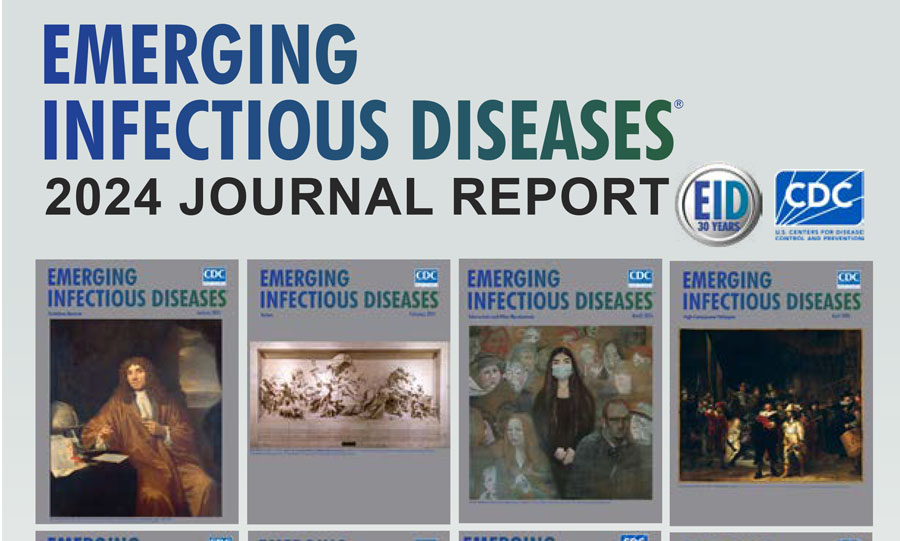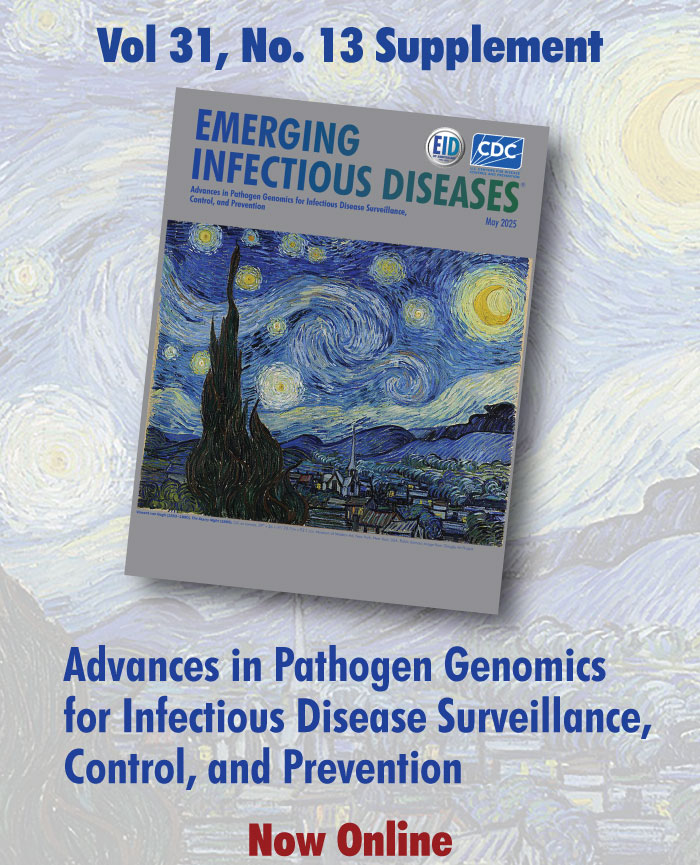Medscape CME Activity
Medscape, LLC is pleased to provide online continuing medical education (CME) for selected journal articles, allowing clinicians the opportunity to earn CME credit. In support of improving patient care, these activities have been planned and implemented by Medscape, LLC and Emerging Infectious Diseases. Medscape, LLC is jointly accredited by the Accreditation Council for Continuing Medical Education (ACCME), the Accreditation Council for Pharmacy Education (ACPE), and the American Nurses Credentialing Center (ANCC), to provide continuing education for the healthcare team.
CME credit is available for one year after publication.
Volume 24—2018
Volume 24, Number 12—December 2018
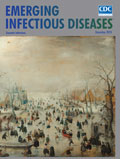
We summarize and analyze historical and current data regarding the reemergence of St. Louis encephalitis virus (SLEV; genus Flavivirus) in the Americas. Historically, SLEV caused encephalitis outbreaks in the United States; however, it was not considered a public health concern in the rest of the Americas. After the introduction of West Nile virus in 1999, activity of SLEV decreased considerably in the United States. During 2014–2015, SLEV caused a human outbreak in Arizona and caused isolated human cases in California in 2016 and 2017. Phylogenetic analyses indicate that the emerging SLEV in the western United States is related to the epidemic strains isolated during a human encephalitis outbreak in Córdoba, Argentina, in 2005. Ecoepidemiologic studies suggest that the emergence of SLEV in Argentina was caused by the introduction of a more pathogenic strain and increasing populations of the eared dove (amplifying host).
| EID | Diaz A, Coffey LL, Burkett-Cadena N, Day JF. Reemergence of St. Louis Encephalitis Virus in the Americas. Emerg Infect Dis. 2018;24(12):2150-2157. https://doi.org/10.3201/eid2412.180372 |
|---|---|
| AMA | Diaz A, Coffey LL, Burkett-Cadena N, et al. Reemergence of St. Louis Encephalitis Virus in the Americas. Emerging Infectious Diseases. 2018;24(12):2150-2157. doi:10.3201/eid2412.180372. |
| APA | Diaz, A., Coffey, L. L., Burkett-Cadena, N., & Day, J. F. (2018). Reemergence of St. Louis Encephalitis Virus in the Americas. Emerging Infectious Diseases, 24(12), 2150-2157. https://doi.org/10.3201/eid2412.180372. |
The effectiveness of oral HIV preexposure prophylaxis (PrEP) strongly depends on maintaining adherence. We investigated the association between substance use and PrEP adherence, as well as incident sexually transmitted infections (STIs) in a high-risk cohort of 394 participants (391 men who have sex with men and 3 transgender women) who were enrolled in a PrEP demonstration project. We assessed baseline and ongoing substance use over a 48-week period for stimulants and nonstimulant substances and for each substance separately. We measured PrEP adherence by using dried blood spots to obtain levels of tenofovir diphosphate. No differences in these levels were found between substance users and nonsubstance users. Baseline stimulant use was strongly associated (odds ratio 3.4; p<0.001) with incident STIs during the study. Thus, PrEP adherence was not decreased by substance use. Because substance users had increased rates of STIs, indicating higher-risk behavior, they might be excellent candidates for PrEP.
| EID | Hoenigl M, Jain S, Moore D, Collins D, Sun X, Anderson PL, et al. Substance Use and Adherence to HIV Preexposure Prophylaxis for Men Who Have Sex with Men. Emerg Infect Dis. 2018;24(12):2292-2302. https://doi.org/10.3201/eid2412.180400 |
|---|---|
| AMA | Hoenigl M, Jain S, Moore D, et al. Substance Use and Adherence to HIV Preexposure Prophylaxis for Men Who Have Sex with Men. Emerging Infectious Diseases. 2018;24(12):2292-2302. doi:10.3201/eid2412.180400. |
| APA | Hoenigl, M., Jain, S., Moore, D., Collins, D., Sun, X., Anderson, P. L....Morris, S. (2018). Substance Use and Adherence to HIV Preexposure Prophylaxis for Men Who Have Sex with Men. Emerging Infectious Diseases, 24(12), 2292-2302. https://doi.org/10.3201/eid2412.180400. |
Volume 24, Number 11—November 2018

We evaluated formalin-fixed paraffin-embedded tissue specimens from 7 patients who died with encephalitic typhus in Hamburg, Germany, during World War II. The archived specimens included only central nervous system tissues >70 years old that had been stored at room temperature. We demonstrated successful detection of Rickettsia typhi DNA by a nested qPCR specific to prsA in 2 patients. These results indicate that R. typhi infections contributed to typhus outbreaks during World War II. Immunohistochemical analyses of brain tissue specimens of R. typhi DNA–positive and –negative specimens showed perivascular B-cell accumulation. Around blood vessels, nodular cell accumulations consisted of CD4-positive and CD8-positive T cells and CD68-positive microglia and macrophages; neutrophils were found rarely. These findings are similar to those of previously reported R. prowazekii tissue specimen testing. Because R. typhi and R. prowazekii infections can be clinically and histopathologically similar, molecular analyses should be performed to distinguish the 2 pathogens.
| EID | Rauch J, Muntau B, Eggert P, Tappe D. Rickettsia typhi as Cause of Fatal Encephalitic Typhus in Hospitalized Patients, Hamburg, Germany, 1940–1944. Emerg Infect Dis. 2018;24(11):1982-1987. https://doi.org/10.3201/eid2411.171373 |
|---|---|
| AMA | Rauch J, Muntau B, Eggert P, et al. Rickettsia typhi as Cause of Fatal Encephalitic Typhus in Hospitalized Patients, Hamburg, Germany, 1940–1944. Emerging Infectious Diseases. 2018;24(11):1982-1987. doi:10.3201/eid2411.171373. |
| APA | Rauch, J., Muntau, B., Eggert, P., & Tappe, D. (2018). Rickettsia typhi as Cause of Fatal Encephalitic Typhus in Hospitalized Patients, Hamburg, Germany, 1940–1944. Emerging Infectious Diseases, 24(11), 1982-1987. https://doi.org/10.3201/eid2411.171373. |
Cryptococcus gattii traditionally infects immunocompetent hosts and causes devastating pulmonary or central nervous system disease. However, this infection rarely occurs in patients infected with HIV. We report 3 cases of HIV-associated C. gattii complex infections in the southeastern United States. Detection of C. gattii in HIV-infected patients in this region warrants increased awareness of this threat to ensure appropriate diagnosis and treatment to optimize patient outcomes.
| EID | Bruner KT, Franco-Paredes C, Henao-Martínez AF, Steele GM, Chastain DB. Cryptococcus gattii Complex Infections in HIV-Infected Patients, Southeastern United States. Emerg Infect Dis. 2018;24(11):1998-2002. https://doi.org/10.3201/eid2411.180787 |
|---|---|
| AMA | Bruner KT, Franco-Paredes C, Henao-Martínez AF, et al. Cryptococcus gattii Complex Infections in HIV-Infected Patients, Southeastern United States. Emerging Infectious Diseases. 2018;24(11):1998-2002. doi:10.3201/eid2411.180787. |
| APA | Bruner, K. T., Franco-Paredes, C., Henao-Martínez, A. F., Steele, G. M., & Chastain, D. B. (2018). Cryptococcus gattii Complex Infections in HIV-Infected Patients, Southeastern United States. Emerging Infectious Diseases, 24(11), 1998-2002. https://doi.org/10.3201/eid2411.180787. |
Volume 24, Number 10—October 2018
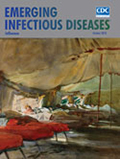
Human pegivirus (HPgV), previously called hepatitis G virus or GB virus C, is a lymphotropic virus with undefined pathology. Because many viruses from the family Flaviviridae, to which HPgV belongs, are neurotropic, we studied whether HPgV could infect the central nervous system. We tested serum and cerebrospinal fluid samples from 96 patients with a diagnosis of encephalitis for a variety of pathogens by molecular methods and serology; we also tested for autoantibodies against neuronal antigens. We found HPgV in serum and cerebrospinal fluid from 3 patients who had encephalitis of unclear origin; that is, all the markers that had been tested were negative. Single-strand confirmation polymorphism and next-generation sequencing analysis revealed differences between the serum and cerebrospinal fluid–derived viral sequences, which is compatible with the presence of a separate HPgV compartment in the central nervous system. It is unclear whether HPgV was directly responsible for encephalitis in these patients.
| EID | Bukowska-Ośko I, Perlejewski K, Pawełczyk A, Rydzanicz M, Pollak A, Popiel M, et al. Human Pegivirus in Patients with Encephalitis of Unclear Etiology, Poland. Emerg Infect Dis. 2018;24(10):1785-1794. https://doi.org/10.3201/eid2410.180161 |
|---|---|
| AMA | Bukowska-Ośko I, Perlejewski K, Pawełczyk A, et al. Human Pegivirus in Patients with Encephalitis of Unclear Etiology, Poland. Emerging Infectious Diseases. 2018;24(10):1785-1794. doi:10.3201/eid2410.180161. |
| APA | Bukowska-Ośko, I., Perlejewski, K., Pawełczyk, A., Rydzanicz, M., Pollak, A., Popiel, M....Laskus, T. (2018). Human Pegivirus in Patients with Encephalitis of Unclear Etiology, Poland. Emerging Infectious Diseases, 24(10), 1785-1794. https://doi.org/10.3201/eid2410.180161. |
During August 2012–November 2014, we conducted a case ascertainment study to investigate household transmission of influenza virus in Managua, Nicaragua. We collected up to 5 respiratory swab samples from each of 536 household contacts of 133 influenza virus–infected persons and assessed for evidence of influenza virus transmission. The overall risk for influenza virus infection of household contacts was 15.7% (95% CI 12.7%–19.0%). Oseltamivir treatment of index patients did not appear to reduce household transmission. The mean serial interval for within-household transmission was 3.1 (95% CI 1.6–8.4) days. We found the transmissibility of influenza B virus to be higher than that of influenza A virus among children. Compared with households with <4 household contacts, those with >4 household contacts appeared to have a reduced risk for infection. Further research is needed to model household influenza virus transmission and design interventions for these settings.
| EID | Gordon A, Tsang TK, Cowling BJ, Kuan G, Ojeda S, Sanchez N, et al. Influenza Transmission Dynamics in Urban Households, Managua, Nicaragua, 2012–2014. Emerg Infect Dis. 2018;24(10):1882-1888. https://doi.org/10.3201/eid2410.161258 |
|---|---|
| AMA | Gordon A, Tsang TK, Cowling BJ, et al. Influenza Transmission Dynamics in Urban Households, Managua, Nicaragua, 2012–2014. Emerging Infectious Diseases. 2018;24(10):1882-1888. doi:10.3201/eid2410.161258. |
| APA | Gordon, A., Tsang, T. K., Cowling, B. J., Kuan, G., Ojeda, S., Sanchez, N....Harris, E. (2018). Influenza Transmission Dynamics in Urban Households, Managua, Nicaragua, 2012–2014. Emerging Infectious Diseases, 24(10), 1882-1888. https://doi.org/10.3201/eid2410.161258. |
Volume 24, Number 9—September 2018
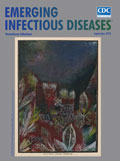
We report results from a national surveillance program for Clostridioides difficile infection (CDI) in Sweden, where CDI incidence decreased by 22% and the proportion of multidrug-resistant isolates decreased by 80% during 2012–2016. Variation in incidence between counties also diminished during this period, which might be attributable to implementation of nucleic acid amplification testing as the primary diagnostic tool for most laboratories. In contrast to other studies, our study did not indicate increased CDI incidence attributable the introduction of nucleic acid amplification testing. Our results also suggest that successful implementation of hygiene measures is the major cause of the observed incidence decrease. Despite substantial reductions in CDI incidence and prevalence of multidrug-resistant isolates, Sweden still has one of the highest CDI incidence levels in Europe. This finding is unexpected and warrants further investigation, given that Sweden has among the lowest levels of antimicrobial drug use.
| EID | Rizzardi K, Norén T, Aspevall O, Mäkitalo B, Toepfer M, Johansson Å, et al. National Surveillance for Clostridioides difficile Infection, Sweden, 2009–2016. Emerg Infect Dis. 2018;24(9):1617-1625. https://doi.org/10.3201/eid2409.171658 |
|---|---|
| AMA | Rizzardi K, Norén T, Aspevall O, et al. National Surveillance for Clostridioides difficile Infection, Sweden, 2009–2016. Emerging Infectious Diseases. 2018;24(9):1617-1625. doi:10.3201/eid2409.171658. |
| APA | Rizzardi, K., Norén, T., Aspevall, O., Mäkitalo, B., Toepfer, M., Johansson, Å....Åkerlund, T. (2018). National Surveillance for Clostridioides difficile Infection, Sweden, 2009–2016. Emerging Infectious Diseases, 24(9), 1617-1625. https://doi.org/10.3201/eid2409.171658. |
Volume 24, Number 8—August 2018
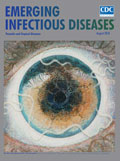
Since the first identification of neonatal microcephaly cases associated with congenital Zika virus infection in Brazil in 2015, a distinctive constellation of clinical features of congenital Zika syndrome has been described. Fetal brain disruption sequence is hypothesized to underlie the devastating effects of the virus on the central nervous system. However, little is known about the effects of congenital Zika virus infection on the peripheral nervous system. We describe a series of 4 cases of right unilateral diaphragmatic paralysis in infants with congenital Zika syndrome suggesting peripheral nervous system involvement and Zika virus as a unique congenital infectious cause of this finding. All the patients described also had arthrogryposis (including talipes equinovarus) and died from complications related to progressive respiratory failure.
| EID | Rajapakse NS, Ellsworth K, Liesman RM, Ho M, Henry N, Theel ES, et al. Unilateral Phrenic Nerve Palsy in Infants with Congenital Zika Syndrome. Emerg Infect Dis. 2018;24(8):1422-1427. https://doi.org/10.3201/eid2408.180057 |
|---|---|
| AMA | Rajapakse NS, Ellsworth K, Liesman RM, et al. Unilateral Phrenic Nerve Palsy in Infants with Congenital Zika Syndrome. Emerging Infectious Diseases. 2018;24(8):1422-1427. doi:10.3201/eid2408.180057. |
| APA | Rajapakse, N. S., Ellsworth, K., Liesman, R. M., Ho, M., Henry, N., Theel, E. S....Meneses, J. (2018). Unilateral Phrenic Nerve Palsy in Infants with Congenital Zika Syndrome. Emerging Infectious Diseases, 24(8), 1422-1427. https://doi.org/10.3201/eid2408.180057. |
During 2012–2015, US-bound refugees living in Myanmar–Thailand border camps (n = 1,839) were surveyed for hookworm infection and treatment response by using quantitative PCR. Samples were collected at 3 time points: after each of 2 treatments with albendazole and after resettlement in the United States. Baseline prevalence of Necator americanus hookworm was 25.4%, Ancylostoma duodenale 0%, and Ancylostoma ceylanicum (a zoonosis) 5.4%. Compared with N. americanus prevalence, A. ceylanicum hookworm prevalence peaked in younger age groups, and blood eosinophil concentrations during A. ceylanicum infection were higher than those for N. americanus infection. Female sex was associated with a lower risk for either hookworm infection. Cure rates after 1 dose of albendazole were greater for A. ceylanicum (93.3%) than N. americanus (65.9%) hookworm (p<0.001). Lower N. americanus hookworm cure rates were unrelated to β-tubulin single-nucleotide polymorphisms at codons 200 or 167. A. ceylanicum hookworm infection might be more common in humans than previously recognized.
| EID | O’Connell EM, Mitchell T, Papaiakovou M, Pilotte N, Lee D, Weinberg M, et al. Ancylostoma ceylanicum Hookworm in Myanmar Refugees, Thailand, 2012–2015. Emerg Infect Dis. 2018;24(8):1472-1481. https://doi.org/10.3201/eid2408.180280 |
|---|---|
| AMA | O’Connell EM, Mitchell T, Papaiakovou M, et al. Ancylostoma ceylanicum Hookworm in Myanmar Refugees, Thailand, 2012–2015. Emerging Infectious Diseases. 2018;24(8):1472-1481. doi:10.3201/eid2408.180280. |
| APA | O’Connell, E. M., Mitchell, T., Papaiakovou, M., Pilotte, N., Lee, D., Weinberg, M....Nutman, T. B. (2018). Ancylostoma ceylanicum Hookworm in Myanmar Refugees, Thailand, 2012–2015. Emerging Infectious Diseases, 24(8), 1472-1481. https://doi.org/10.3201/eid2408.180280. |
We report 958 cases of cestodiasis occurring in Japan during 2001–2016. The predominant pathogen was Diphyllobothrium nihonkaiense tapeworm (n = 825), which caused 86.1% of all cases. The other cestode species involved were Taenia spp. (10.3%), Diplogonoporus balaenopterae (3.3%), and Spirometra spp. (0.2%). We estimated D. nihonkaiense diphyllobothriasis incidence as 52 cases/year. We observed a predominance of cases during March–July, coinciding with the cherry salmon and immature chum salmon fishing season, but cases were present year-round, suggesting that other fish could be involved in transmission to humans. Because of increased salmon trade, increased tourism in Japan, and lack of awareness of the risks associated with eating raw fish, cases of D. nihonkaiense diphyllobothriasis are expected to rise. Therefore, information regarding these concerning parasitic infections and warnings of the potential risks associated with these infections must be disseminated to consumers, food producers, restaurant owners, physicians, and travelers.
| EID | Ikuno H, Akao S, Yamasaki H. Epidemiology of Diphyllobothrium nihonkaiense Diphyllobothriasis, Japan, 2001–2016. Emerg Infect Dis. 2018;24(8):1428-1434. https://doi.org/10.3201/eid2408.171454 |
|---|---|
| AMA | Ikuno H, Akao S, Yamasaki H. Epidemiology of Diphyllobothrium nihonkaiense Diphyllobothriasis, Japan, 2001–2016. Emerging Infectious Diseases. 2018;24(8):1428-1434. doi:10.3201/eid2408.171454. |
| APA | Ikuno, H., Akao, S., & Yamasaki, H. (2018). Epidemiology of Diphyllobothrium nihonkaiense Diphyllobothriasis, Japan, 2001–2016. Emerging Infectious Diseases, 24(8), 1428-1434. https://doi.org/10.3201/eid2408.171454. |
Volume 24, Number 7—July 2018
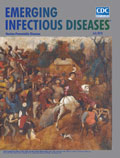
Candidemia is a major cause of healthcare-associated infections. We describe a large outbreak of Candida krusei bloodstream infections among infants in Gauteng Province, South Africa, during a 4-month period; a series of candidemia and bacteremia outbreaks in the neonatal unit followed. We detected cases by using enhanced laboratory surveillance and audited hospital wards by environmental sampling and epidemiologic studies. During July–October 2014, among 589 patients, 48 unique cases of C. krusei candidemia occurred (8.2% incidence). Risk factors for candidemia on multivariable analyses were necrotizing enterocolitis, birthweight <1,500 g, receipt of parenteral nutrition, and receipt of blood transfusion. Despite initial interventions, outbreaks of bloodstream infection caused by C. krusei, rarer fungal species, and bacterial pathogens continued in the neonatal unit through July 29, 2016. Multiple factors contributed to these outbreaks; the most functional response is to fortify infection prevention and control.
| EID | van Schalkwyk E, Iyaloo S, Naicker SD, Maphanga TG, Mpembe RS, Zulu TG, et al. Large Outbreaks of Fungal and Bacterial Bloodstream Infections in a Neonatal Unit, South Africa, 2012–2016. Emerg Infect Dis. 2018;24(7):1204-1212. https://doi.org/10.3201/eid2407.171087 |
|---|---|
| AMA | van Schalkwyk E, Iyaloo S, Naicker SD, et al. Large Outbreaks of Fungal and Bacterial Bloodstream Infections in a Neonatal Unit, South Africa, 2012–2016. Emerging Infectious Diseases. 2018;24(7):1204-1212. doi:10.3201/eid2407.171087. |
| APA | van Schalkwyk, E., Iyaloo, S., Naicker, S. D., Maphanga, T. G., Mpembe, R. S., Zulu, T. G....Govender, N. P. (2018). Large Outbreaks of Fungal and Bacterial Bloodstream Infections in a Neonatal Unit, South Africa, 2012–2016. Emerging Infectious Diseases, 24(7), 1204-1212. https://doi.org/10.3201/eid2407.171087. |
Endemic mycoses represent a growing public health challenge in North America. We describe the epidemiology of 1,392 microbiology laboratory–confirmed cases of blastomycosis, histoplasmosis, and coccidioidomycosis in Ontario during 1990–2015. Blastomycosis was the most common infection (1,092 cases; incidence of 0.41 cases/100,000 population), followed by histoplasmosis (211 cases) and coccidioidomycosis (89 cases). Incidence of blastomycosis increased from 1995 to 2001 and has remained elevated, especially in the northwest region, incorporating several localized hotspots where disease incidence (10.9 cases/100,000 population) is 12.6 times greater than in any other region of the province. This retrospective study substantially increases the number of known endemic fungal infections reported in Canada, confirms Ontario as an important region of endemicity for blastomycosis and histoplasmosis, and provides an epidemiologic baseline for future disease surveillance. Clinicians should include blastomycosis and histoplasmosis in the differential diagnosis of antibiotic-refractory pneumonia in patients traveling to or residing in Ontario.
| EID | Brown EM, McTaggart LR, Dunn D, Pszczolko E, Tsui K, Morris SK, et al. Epidemiology and Geographic Distribution of Blastomycosis, Histoplasmosis, and Coccidioidomycosis, Ontario, Canada, 1990–2015. Emerg Infect Dis. 2018;24(7):1257-1266. https://doi.org/10.3201/eid2407.172063 |
|---|---|
| AMA | Brown EM, McTaggart LR, Dunn D, et al. Epidemiology and Geographic Distribution of Blastomycosis, Histoplasmosis, and Coccidioidomycosis, Ontario, Canada, 1990–2015. Emerging Infectious Diseases. 2018;24(7):1257-1266. doi:10.3201/eid2407.172063. |
| APA | Brown, E. M., McTaggart, L. R., Dunn, D., Pszczolko, E., Tsui, K., Morris, S. K....Richardson, S. E. (2018). Epidemiology and Geographic Distribution of Blastomycosis, Histoplasmosis, and Coccidioidomycosis, Ontario, Canada, 1990–2015. Emerging Infectious Diseases, 24(7), 1257-1266. https://doi.org/10.3201/eid2407.172063. |
Volume 24, Number 6—June 2018
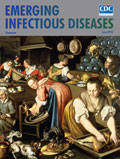
Limbic encephalitis is commonly regarded as an autoimmune-mediated disease. However, after the recent detection of zoonotic variegated squirrel bornavirus 1 in a Prevost’s squirrel (Callosciurus prevostii) in a zoo in northern Germany, we retrospectively investigated a fatal case in an autoantibody-seronegative animal caretaker who had worked at that zoo. The virus had been discovered in 2015 as the cause of a cluster of cases of fatal encephalitis among breeders of variegated squirrels (Sciurus variegatoides) in eastern Germany. Molecular assays and immunohistochemistry detected a limbic distribution of the virus in brain tissue of the animal caretaker. Phylogenetic analyses demonstrated a spillover infection from the Prevost’s squirrel. Antibodies against bornaviruses were detected in the patient’s cerebrospinal fluid by immunofluorescence and newly developed ELISAs and immunoblot. The putative antigenic epitope was identified on the viral nucleoprotein. Other zoo workers were not infected; however, avoidance of direct contact with exotic squirrels and screening of squirrels are recommended.
| EID | Tappe D, Schlottau K, Cadar D, Hoffmann B, Balke L, Bewig B, et al. Occupation-Associated Fatal Limbic Encephalitis Caused by Variegated Squirrel Bornavirus 1, Germany, 2013. Emerg Infect Dis. 2018;24(6):978-987. https://doi.org/10.3201/eid2406.172027 |
|---|---|
| AMA | Tappe D, Schlottau K, Cadar D, et al. Occupation-Associated Fatal Limbic Encephalitis Caused by Variegated Squirrel Bornavirus 1, Germany, 2013. Emerging Infectious Diseases. 2018;24(6):978-987. doi:10.3201/eid2406.172027. |
| APA | Tappe, D., Schlottau, K., Cadar, D., Hoffmann, B., Balke, L., Bewig, B....Beer, M. (2018). Occupation-Associated Fatal Limbic Encephalitis Caused by Variegated Squirrel Bornavirus 1, Germany, 2013. Emerging Infectious Diseases, 24(6), 978-987. https://doi.org/10.3201/eid2406.172027. |
We conducted a multicenter, retrospective cohort study of hospitalized patients with serologically proven nephropathia epidemica (NE) living in Ardennes Department, France, during 2000–2014 to develop a bioclinical test predictive of severe disease. Among 205 patients, 45 (22.0%) had severe NE. We found the following factors predictive of severe NE: nephrotoxic drug exposure (p = 0.005, point value 10); visual disorders (p = 0.02, point value 8); microscopic or macroscopic hematuria (p = 0.04, point value 7); leukocyte count >10 × 109 cells/L (p = 0.01, point value 9); and thrombocytopenia <90 × 109/L (p = 0.003, point value 11). When point values for each factor were summed, we found a score of <10 identified low-risk patients (3.3% had severe disease), and a score >20 identified high-risk patients (45.3% had severe disease). If validated in future studies, this test could be used to stratify patients by severity in research studies and in clinical practice.
| EID | Hentzien M, Mestrallet S, Halin P, Pannet L, Lebrun D, Dramé M, et al. Bioclinical Test to Predict Nephropathia Epidemica Severity at Hospital Admission. Emerg Infect Dis. 2018;24(6):1045-1054. https://doi.org/10.3201/eid2406.172160 |
|---|---|
| AMA | Hentzien M, Mestrallet S, Halin P, et al. Bioclinical Test to Predict Nephropathia Epidemica Severity at Hospital Admission. Emerging Infectious Diseases. 2018;24(6):1045-1054. doi:10.3201/eid2406.172160. |
| APA | Hentzien, M., Mestrallet, S., Halin, P., Pannet, L., Lebrun, D., Dramé, M....Servettaz, A. (2018). Bioclinical Test to Predict Nephropathia Epidemica Severity at Hospital Admission. Emerging Infectious Diseases, 24(6), 1045-1054. https://doi.org/10.3201/eid2406.172160. |
Volume 24, Number 5—May 2018
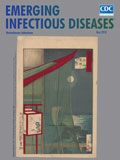
A large number of imported cases of Zika virus infection and the potential for transmission by Aedes albopictus mosquitoes prompted the New York City Department of Health and Mental Hygiene to conduct sentinel, enhanced passive, and syndromic surveillance for locally acquired mosquitoborne Zika virus infections in New York City, NY, USA, during June–October 2016. Suspected case-patients were those >5 years of age without a travel history or sexual exposure who had >3 compatible signs/symptoms (arthralgia, fever, conjunctivitis, or rash). We identified 15 suspected cases and tested urine samples for Zika virus by using real-time reverse transcription PCR; all results were negative. We identified 308 emergency department visits for Zika-like illness, 40,073 visits for fever, and 17 unique spatiotemporal clusters of visits for fever. We identified no evidence of local transmission. Our experience offers possible surveillance tools for jurisdictions concerned about local mosquitoborne Zika virus or other arboviral transmission.
| EID | Wahnich A, Clark S, Bloch D, Kubinson H, Hrusa G, Liu D, et al. Surveillance for Mosquitoborne Transmission of Zika Virus, New York City, NY, USA, 2016. Emerg Infect Dis. 2018;24(5):827-834. https://doi.org/10.3201/eid2405.170764 |
|---|---|
| AMA | Wahnich A, Clark S, Bloch D, et al. Surveillance for Mosquitoborne Transmission of Zika Virus, New York City, NY, USA, 2016. Emerging Infectious Diseases. 2018;24(5):827-834. doi:10.3201/eid2405.170764. |
| APA | Wahnich, A., Clark, S., Bloch, D., Kubinson, H., Hrusa, G., Liu, D....Conners, E. E. (2018). Surveillance for Mosquitoborne Transmission of Zika Virus, New York City, NY, USA, 2016. Emerging Infectious Diseases, 24(5), 827-834. https://doi.org/10.3201/eid2405.170764. |
We report a series of 5 case-patients who had Israeli spotted fever, of whom 2 had purpura fulminans and died. Four case-patients were given a diagnosis on the basis of PCR of skin biopsy specimens 3–4 days after treatment with doxycycline; 1 case-patient was given a diagnosis on the basis of seroconversion. Rickettsia spp. from the 2 case-patients who died were sequenced and identified as Rickettsia conorii subsp. israelensis. Purpura fulminans has been described in association with R. rickettsii and R. indica, but rarely with R. conorii subsp. israelensis.
| EID | Cohen R, Babushkin F, Shapiro M, Uda M, Atiya-Nasagi Y, Klein D, et al. Two Cases of Israeli Spotted Fever with Purpura Fulminans, Sharon District, Israel. Emerg Infect Dis. 2018;24(5):835-840. https://doi.org/10.3201/eid2405.171992 |
|---|---|
| AMA | Cohen R, Babushkin F, Shapiro M, et al. Two Cases of Israeli Spotted Fever with Purpura Fulminans, Sharon District, Israel. Emerging Infectious Diseases. 2018;24(5):835-840. doi:10.3201/eid2405.171992. |
| APA | Cohen, R., Babushkin, F., Shapiro, M., Uda, M., Atiya-Nasagi, Y., Klein, D....Finn, T. (2018). Two Cases of Israeli Spotted Fever with Purpura Fulminans, Sharon District, Israel. Emerging Infectious Diseases, 24(5), 835-840. https://doi.org/10.3201/eid2405.171992. |
Volume 24, Number 4—April 2018
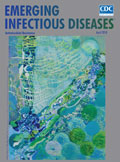
We conducted a yearlong prospective study of febrile patients admitted to a tertiary referral hospital in Chittagong, Bangladesh, to assess the proportion of patients with rickettsial illnesses and identify the causative pathogens, strain genotypes, and associated seasonality patterns. We diagnosed scrub typhus in 16.8% (70/416) and murine typhus in 5.8% (24/416) of patients; 2 patients had infections attributable to undifferentiated Rickettsia spp. and 2 had DNA sequence–confirmed R. felis infection. Orientia tsutsugamushi genotypes included Karp, Gilliam, Kato, and TA763-like strains, with a prominence of Karp-like strains. Scrub typhus admissions peaked in a biphasic pattern before and after the rainy season, whereas murine typhus more frequently occurred before the rainy season. Death occurred in 4% (18/416) of cases; case-fatality rates were 4% each for scrub typhus (3/70) and murine typhus (1/28). Overall, 23.1% (96/416) of patients had evidence of treatable rickettsial illnesses, providing important evidence toward optimizing empirical treatment strategies.
| EID | Kingston HW, Hossain M, Leopold S, Anantatat T, Tanganuchitcharnchai A, Sinha I, et al. Rickettsial Illnesses as Important Causes of Febrile Illness in Chittagong, Bangladesh. Emerg Infect Dis. 2018;24(4):638-645. https://doi.org/10.3201/eid2404.170190 |
|---|---|
| AMA | Kingston HW, Hossain M, Leopold S, et al. Rickettsial Illnesses as Important Causes of Febrile Illness in Chittagong, Bangladesh. Emerging Infectious Diseases. 2018;24(4):638-645. doi:10.3201/eid2404.170190. |
| APA | Kingston, H. W., Hossain, M., Leopold, S., Anantatat, T., Tanganuchitcharnchai, A., Sinha, I....Paris, D. H. (2018). Rickettsial Illnesses as Important Causes of Febrile Illness in Chittagong, Bangladesh. Emerging Infectious Diseases, 24(4), 638-645. https://doi.org/10.3201/eid2404.170190. |
The epidemic of illicit intravenous drug use (IVDU) in the United States has been accompanied by a surge in drug overdose deaths and infectious sequelae. Candida albicans infections were associated with injection of contaminated impure brown heroin in the 1970s–1990s; however, candidiasis accompanying IVDU became considerably rarer as the purity of the heroin supply increased. We reviewed cases of candidemia occurring over a recent 7-year period in persons >14 years of age at a tertiary care hospital in central Massachusetts. Of the 198 patients with candidemia, 24 cases occurred in patients with a history of IVDU. Compared with non-IVDU patients, those with a history of IVDU were more likely to have non-albicans Candida, be co-infected with hepatitis C, and have end-organ involvement, including endocarditis and osteomyelitis. Thus, IVDU appears to be reemerging as a risk factor for invasive candidiasis.
| EID | Poowanawittayakom N, Dutta A, Stock S, Touray S, Ellison RT, Levitz SM. Reemergence of Intravenous Drug Use as Risk Factor for Candidemia, Massachusetts, USA. Emerg Infect Dis. 2018;24(4):631-637. https://doi.org/10.3201/eid2404.171807 |
|---|---|
| AMA | Poowanawittayakom N, Dutta A, Stock S, et al. Reemergence of Intravenous Drug Use as Risk Factor for Candidemia, Massachusetts, USA. Emerging Infectious Diseases. 2018;24(4):631-637. doi:10.3201/eid2404.171807. |
| APA | Poowanawittayakom, N., Dutta, A., Stock, S., Touray, S., Ellison, R. T., & Levitz, S. M. (2018). Reemergence of Intravenous Drug Use as Risk Factor for Candidemia, Massachusetts, USA. Emerging Infectious Diseases, 24(4), 631-637. https://doi.org/10.3201/eid2404.171807. |
Volume 24, Number 3—March 2018
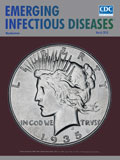
Using China’s national surveillance data on hand, foot and mouth disease (HFMD) for 2008–2015, we described the epidemiologic and virologic features of recurrent HFMD. A total of 398,010 patients had HFMD recurrence; 1,767 patients had 1,814 cases of recurrent laboratory-confirmed HFMD: 99 reinfections of enterovirus A71 (EV-A71) with EV-A71, 45 of coxsackievirus A16 (CV-A16) with CV-A16, 364 of other enteroviruses with other enteroviruses, 383 of EV-A71 with CV-A16 and CV-A16 with EV-A71, and 923 of EV-A71 or CV-A16 with other enteroviruses and other enteroviruses with EV-A71 or CV-A16. The probability of HFMD recurrence was 1.9% at 12 months, 3.3% at 24 months, 3.9% at 36 months, and 4.0% at 38.8 months after the primary episode. HFMD severity was not associated with recurrent episodes or time interval between episodes. Elucidation of the mechanism underlying HFMD recurrence with the same enterovirus serotype and confirmation that HFMD recurrence is not associated with disease severity is needed.
| EID | Huang J, Liao Q, Ooi M, Cowling BJ, Chang Z, Wu P, et al. Epidemiology of Recurrent Hand, Foot and Mouth Disease, China, 2008–2015. Emerg Infect Dis. 2018;24(3):432-442. https://doi.org/10.3201/eid2403.171303 |
|---|---|
| AMA | Huang J, Liao Q, Ooi M, et al. Epidemiology of Recurrent Hand, Foot and Mouth Disease, China, 2008–2015. Emerging Infectious Diseases. 2018;24(3):432-442. doi:10.3201/eid2403.171303. |
| APA | Huang, J., Liao, Q., Ooi, M., Cowling, B. J., Chang, Z., Wu, P....Wei, S. (2018). Epidemiology of Recurrent Hand, Foot and Mouth Disease, China, 2008–2015. Emerging Infectious Diseases, 24(3), 432-442. https://doi.org/10.3201/eid2403.171303. |
Volume 24, Number 2—February 2018
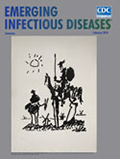
Liver abscesses containing hypervirulent Klebsiella pneumoniae have emerged during the past 2 decades, originally in Southeast Asia and then worldwide. We hypothesized that hypervirulent K. pneumoniae might also be emerging in France. In a retrospective, monocentric, cohort study, we analyzed characteristics and outcomes for 199 consecutive patients in Paris, France, with liver abscesses during 2010−2015. We focused on 31 patients with abscesses containing K. pneumoniae. This bacterium was present in most (14/27, 52%) cryptogenic liver abscesses. Cryptogenic K. pneumoniae abscesses were more frequently community-acquired (p<0.00001) and monomicrobial (p = 0.008), less likely to involve cancer patients (p<0.01), and relapsed less often (p<0.01) than did noncryptogenic K. pneumoniae liver abscesses. K. pneumoniae isolates from cryptogenic abscesses belonged to either the K1 or K2 serotypes and had more virulence factors than noncryptogenic K. pneumoniae isolates. Hypervirulent K. pneumoniae are emerging as the main pathogen isolated from cryptogenic liver abscesses in the study area.
| EID | Rossi B, Gasperini M, Leflon-Guibout V, Gioanni A, de Lastours V, Rossi G, et al. Hypervirulent Klebsiella pneumoniae in Cryptogenic Liver Abscesses, Paris, France. Emerg Infect Dis. 2018;24(2):221-229. https://doi.org/10.3201/eid2402.170957 |
|---|---|
| AMA | Rossi B, Gasperini M, Leflon-Guibout V, et al. Hypervirulent Klebsiella pneumoniae in Cryptogenic Liver Abscesses, Paris, France. Emerging Infectious Diseases. 2018;24(2):221-229. doi:10.3201/eid2402.170957. |
| APA | Rossi, B., Gasperini, M., Leflon-Guibout, V., Gioanni, A., de Lastours, V., Rossi, G....Lefort, A. (2018). Hypervirulent Klebsiella pneumoniae in Cryptogenic Liver Abscesses, Paris, France. Emerging Infectious Diseases, 24(2), 221-229. https://doi.org/10.3201/eid2402.170957. |
Staphylococcal toxic shock syndrome (TSS) was originally described in menstruating women and linked to TSS toxin 1 (TSST-1)–producing Staphylococcus aureus. Using UK national surveillance data, we ascertained clinical, molecular and superantigenic characteristics of TSS cases. Average annual TSS incidence was 0.07/100,000 population. Patients with nonmenstrual TSS were younger than those with menstrual TSS but had the same mortality rate. Children <16 years of age accounted for 39% of TSS cases, most caused by burns and skin and soft tissue infections. Nonmenstrual TSS is now more common than menstrual TSS in the UK, although both types are strongly associated with the tst+ clonal complex (CC) 30 methicillin-sensitive S. aureus lineage, which accounted for 49.4% of all TSS and produced more TSST-1 and superantigen bioactivity than did tst+ CC30 methicillin-resistant S. aureus strains. Better understanding of this MSSA lineage and infections in children could focus interventions to prevent TSS in the future.
| EID | Sharma H, Smith D, Turner CE, Game L, Pichon B, Hope R, et al. Clinical and Molecular Epidemiology of Staphylococcal Toxic Shock Syndrome in the United Kingdom. Emerg Infect Dis. 2018;24(2):258-266. https://doi.org/10.3201/eid2402.170606 |
|---|---|
| AMA | Sharma H, Smith D, Turner CE, et al. Clinical and Molecular Epidemiology of Staphylococcal Toxic Shock Syndrome in the United Kingdom. Emerging Infectious Diseases. 2018;24(2):258-266. doi:10.3201/eid2402.170606. |
| APA | Sharma, H., Smith, D., Turner, C. E., Game, L., Pichon, B., Hope, R....Sriskandan, S. (2018). Clinical and Molecular Epidemiology of Staphylococcal Toxic Shock Syndrome in the United Kingdom. Emerging Infectious Diseases, 24(2), 258-266. https://doi.org/10.3201/eid2402.170606. |
Volume 24, Number 1—January 2018
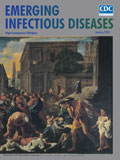
Infections caused by pan–azole-resistant Aspergillus fumigatus strains have emerged in Europe and recently in the United States. Physicians specializing in infectious diseases reported observing pan–azole-resistant infections and low rates of susceptibility testing, suggesting the need for wider-scale testing.
| EID | Walker TA, Lockhart SR, Beekmann SE, Polgreen PM, Santibanez S, Mody RK, et al. Recognition of Azole-Resistant Aspergillosis by Physicians Specializing in Infectious Diseases, United States. Emerg Infect Dis. 2018;24(1):111-113. https://doi.org/10.3201/eid2401.170971 |
|---|---|
| AMA | Walker TA, Lockhart SR, Beekmann SE, et al. Recognition of Azole-Resistant Aspergillosis by Physicians Specializing in Infectious Diseases, United States. Emerging Infectious Diseases. 2018;24(1):111-113. doi:10.3201/eid2401.170971. |
| APA | Walker, T. A., Lockhart, S. R., Beekmann, S. E., Polgreen, P. M., Santibanez, S., Mody, R. K....Jackson, B. R. (2018). Recognition of Azole-Resistant Aspergillosis by Physicians Specializing in Infectious Diseases, United States. Emerging Infectious Diseases, 24(1), 111-113. https://doi.org/10.3201/eid2401.170971. |
Zika virus infection during pregnancy can lead to congenital Zika syndrome. Implementation of screening programs and interpretation of test results can be particularly challenging during ongoing local mosquitoborne transmission. We conducted a retrospective chart review of 2,327 pregnant women screened for Zika virus in Miami–Dade County, Florida, USA, during 2016. Of these, 86 had laboratory evidence of Zika virus infection; we describe 2 infants with probable congenital Zika syndrome. Delays in receipt of laboratory test results (median 42 days) occurred during the first month of local transmission. Odds of screening positive for Zika virus were higher for women without health insurance or who did not speak English. Our findings indicate the increase in screening for Zika virus can overwhelm hospital and public health systems, resulting in delayed receipt of results of screening and confirmatory tests and the potential to miss cases or delay diagnoses.
| EID | Shiu C, Starker R, Kwal J, Bartlett M, Crane A, Greissman S, et al. Zika Virus Testing and Outcomes during Pregnancy, Florida, USA, 2016. Emerg Infect Dis. 2018;24(1):1-8. https://doi.org/10.3201/eid2401.170979 |
|---|---|
| AMA | Shiu C, Starker R, Kwal J, et al. Zika Virus Testing and Outcomes during Pregnancy, Florida, USA, 2016. Emerging Infectious Diseases. 2018;24(1):1-8. doi:10.3201/eid2401.170979. |
| APA | Shiu, C., Starker, R., Kwal, J., Bartlett, M., Crane, A., Greissman, S....Curry, C. L. (2018). Zika Virus Testing and Outcomes during Pregnancy, Florida, USA, 2016. Emerging Infectious Diseases, 24(1), 1-8. https://doi.org/10.3201/eid2401.170979. |
CME Articles by Volume
